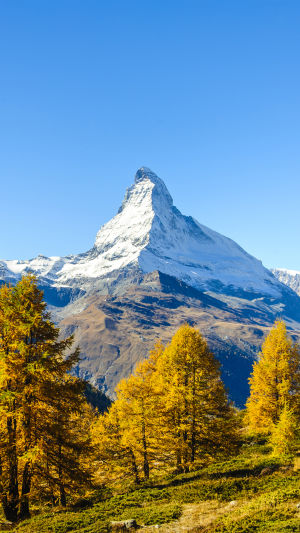A mountain range is a series of mountains that extend in a particular direction, including multiple mountain ranges and valleys. It is named as such because it resembles a vein and has an overall nature that can be referred to as a whole. So, what are the most famous mountain ranges in the world?
1. The Alps
Located in south-central Europe, the Alps stretch from near Nice, France, on the subtropical Mediterranean coast, north to Lake Geneva, and then northeast to Vienna on the Danube. The arc-shaped mountain range is 1,200 km long and 130 km - 260 km wide, with an average altitude of about 3,000 meters and a total area of about 220,000 square kilometers.
Eighty-two of its peaks exceed 4,000 meters in elevation, with the highest peak being Mont Blanc at 4,810 meters, which lies on the border of France, Italy, and Switzerland.
The Alps are the largest mountain range in Europe and also function as a significant watershed, originating many of Europe's great rivers, such as the Danube and Rhine. The upper reaches of each river are characterized by typical mountain rivers with fast-flowing water and abundant hydraulic resources.
2. Rocky Mountains
The Rocky Mountains are the backbone of the Cordillera of America in North America, consisting of several small mountain ranges. They are known as the "backbone" of North America, extending over 4800 kilometers from British Columbia, Canada, to New Mexico in the southwestern United States. They are vast and lack vegetation.
The mountains take their name from an Indian tribe. The majestic Rocky Mountains stretch for thousands of kilometers from north to south. The entire Rocky Mountain range is made up of numerous smaller ranges, of which 39 have names. Except for the St. Lawrence River, almost all of the major rivers in North America originate in the Rocky Mountains, making them an important continental watershed.
3. The Andes
The Andes are part of the Cordillera, also known as the Andes or the Andes, and are located on the west coast of South America. They are over 8,900 kilometers long from north to south, making them the longest mountain range in the world. The Andes stretch from the southern tip of South America to the northernmost Caribbean coast, forming a continuous barrier.
The Andes separate the narrow west coast region from the rest of the continent, and they are one of the Earth's most important topographic features, profoundly affecting the living conditions of the mountains themselves and their surrounding areas. Mount Aconcagua, located in Argentina, is the highest peak in the Western and Southern Hemispheres, reaching 6,962 meters, and is the highest-extinct volcano in the world.
4. Kilimanjaro
Mount Kilimanjaro is in northeastern Tanzania, about 160 kilometers south of the East African Rift Valley. It is the watershed between Tanzania and Kenya, the highest mountain range in Africa, and is also a volcano and a snow mountain.
The main body of the mountain extends nearly 80 kilometers in an east-west direction and consists mainly of three extinct volcanoes: Kibo, Mawinsi, and Hira. It covers an area of 756 square kilometers, and its central volcanic cone, Hulu Peak, at 5,895 meters, is the highest point in Africa.
The Mount Kilimanjaro area has been a designated national park since 1968, and it is home to hot, temperate, and cold wild plants and wildlife. The United Nations Educational, Scientific, and Cultural Organization inscribed it on the World Heritage List for the Protection of Cultural and Natural Heritage in 1981.





